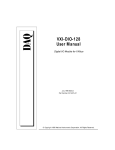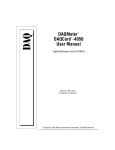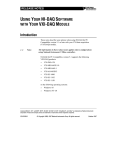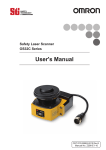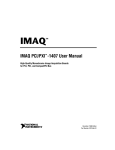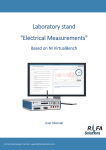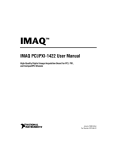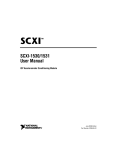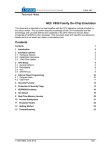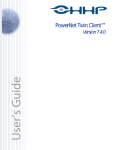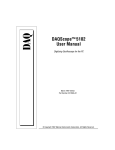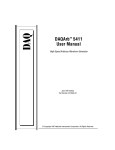Download VXI-AO-48XDC User Manual
Transcript
DAQ VXI-AO-48XDC User Manual DC Setpoint Module for VXIbus VXI-AO-48XDC User Manual March 1999 Edition Part Number 321403B-01 Worldwide Technical Support and Product Information www.natinst.com National Instruments Corporate Headquarters 11500 North Mopac Expressway Austin, Texas 78759-3504 USA Tel: 512 794 0100 Worldwide Offices Australia 03 9879 5166, Austria 0662 45 79 90 0, Belgium 02 757 00 20, Brazil 011 284 5011, Canada (Ontario) 905 785 0085, Canada (Québec) 514 694 8521, China 0755 3904939, Denmark 45 76 26 00, Finland 09 725 725 11, France 01 48 14 24 24, Germany 089 741 31 30, Hong Kong 2645 3186, India 91805275406, Israel 03 6120092, Italy 02 413091, Japan 03 5472 2970, Korea 02 596 7456, Mexico (D.F.) 5 280 7625, Mexico (Monterrey) 8 357 7695, Netherlands 0348 433466, Norway 32 27 73 00, Singapore 2265886, Spain (Madrid) 91 640 0085, Spain (Barcelona) 93 582 0251, Sweden 08 587 895 00, Switzerland 056 200 51 51, Taiwan 02 2377 1200, United Kingdom 01635 523545 For further support information, see the Technical Support Resources appendix. To comment on the documentation, send e-mail to [email protected]. © Copyright 1997, 1999 National Instruments Corporation. All rights reserved. Important Information Warranty The VXI-AO-48XDC is warranted against defects in materials and workmanship for a period of one year from the date of shipment, as evidenced by receipts or other documentation. National Instruments will, at its option, repair or replace equipment that proves to be defective during the warranty period. This warranty includes parts and labor. The media on which you receive National Instruments software are warranted not to fail to execute programming instructions, due to defects in materials and workmanship, for a period of 90 days from date of shipment, as evidenced by receipts or other documentation. National Instruments will, at its option, repair or replace software media that do not execute programming instructions if National Instruments receives notice of such defects during the warranty period. National Instruments does not warrant that the operation of the software shall be uninterrupted or error free. A Return Material Authorization (RMA) number must be obtained from the factory and clearly marked on the outside of the package before any equipment will be accepted for warranty work. National Instruments will pay the shipping costs of returning to the owner parts which are covered by warranty. National Instruments believes that the information in this document is accurate. The document has been carefully reviewed for technical accuracy. In the event that technical or typographical errors exist, National Instruments reserves the right to make changes to subsequent editions of this document without prior notice to holders of this edition. The reader should consult National Instruments if errors are suspected. In no event shall National Instruments be liable for any damages arising out of or related to this document or the information contained in it. EXCEPT AS SPECIFIED HEREIN, NATIONAL INSTRUMENTS MAKES NO WARRANTIES, EXPRESS OR IMPLIED, AND SPECIFICALLY DISCLAIMS ANY WARRANTY OF MERCHANTABILITY OR FITNESS FOR A PARTICULAR PURPOSE. CUSTOMER’S RIGHT TO RECOVER DAMAGES CAUSED BY FAULT OR NEGLIGENCE ON THE PART OF NATIONAL INSTRUMENTS SHALL BE LIMITED TO THE AMOUNT THERETOFORE PAID BY THE CUSTOMER. NATIONAL INSTRUMENTS WILL NOT BE LIABLE FOR DAMAGES RESULTING FROM LOSS OF DATA, PROFITS, USE OF PRODUCTS, OR INCIDENTAL OR CONSEQUENTIAL DAMAGES, EVEN IF ADVISED OF THE POSSIBILITY THEREOF. This limitation of the liability of National Instruments will apply regardless of the form of action, whether in contract or tort, including negligence. Any action against National Instruments must be brought within one year after the cause of action accrues. National Instruments shall not be liable for any delay in performance due to causes beyond its reasonable control. The warranty provided herein does not cover damages, defects, malfunctions, or service failures caused by owner’s failure to follow the National Instruments installation, operation, or maintenance instructions; owner’s modification of the product; owner’s abuse, misuse, or negligent acts; and power failure or surges, fire, flood, accident, actions of third parties, or other events outside reasonable control. Copyright Under the copyright laws, this publication may not be reproduced or transmitted in any form, electronic or mechanical, including photocopying, recording, storing in an information retrieval system, or translating, in whole or in part, without the prior written consent of National Instruments Corporation. Trademarks ComponentWorks™, CVI™, LabVIEW™, Measure™, natinst.com™, NI-DAQ™, NI-VISA™, RTSI™, SCXI™, and VirtualBench™ are trademarks of National Instruments Corporation. Product and company names mentioned herein are trademarks or trade names of their respective companies. WARNING REGARDING MEDICAL AND CLINICAL USE OF NATIONAL INSTRUMENTS PRODUCTS National Instruments products are not designed with components and testing for a level of reliability suitable for use in or in connection with surgical implants or as critical components in any life support systems whose failure to perform can reasonably be expected to cause significant injury to a human. Applications of National Instruments products involving medical or clinical treatment can create a potential for death or bodily injury caused by product failure, or by errors on the part of the user or application designer. Because each end-user system is customized and differs from National Instruments testing platforms and because a user or application designer may use National Instruments products in combination with other products in a manner not evaluated or contemplated by National Instruments, the user or application designer is ultimately responsible for verifying and validating the suitability of National Instruments products whenever National Instruments products are incorporated in a system or application, including, without limitation, the appropriate design, process and safety level of such system or application. Contents About This Manual How To Use the Manual Set..........................................................................................ix Conventions Used in This Manual.................................................................................ix Chapter 1 Introduction About the VXI-AO-48XDC...........................................................................................1-1 What You Need to Get Started ......................................................................................1-1 Software Programming Choices ....................................................................................1-2 National Instruments Application Software ....................................................1-2 NI-DAQ Driver Software ................................................................................1-3 VXIplug&play Instrument Driver ...................................................................1-3 Optional Equipment .......................................................................................................1-4 Custom Cabling ...............................................................................................1-4 Unpacking ......................................................................................................................1-5 Chapter 2 Configuration and Installation Module Configuration....................................................................................................2-1 VXIbus Logical Address .................................................................................2-3 Hardware Installation.....................................................................................................2-4 Software Installation ......................................................................................................2-5 Chapter 3 Signal Connections I/O Connector Pin Assignments ....................................................................................3-1 Signal Connection Descriptions ......................................................................3-4 Analog Output Signal Connections ...............................................................................3-5 Voltage Output ................................................................................................3-6 Power-up Condition ..........................................................................3-6 Current Output.................................................................................................3-6 Power-up Condition ..........................................................................3-6 Digital I/O Signal Connections......................................................................................3-8 Power-up Condition.........................................................................................3-8 Power Connections ........................................................................................................3-9 © National Instruments Corporation v VXI-AO-48XDC User Manual Contents Chapter 4 Hardware Overview Data Transceivers .......................................................................................................... 4-1 VXIbus Interface Circuitry............................................................................................ 4-2 I/O Connector ................................................................................................................ 4-2 nvRAM/DAC Control..................................................................................... 4-2 Digital I/O Control .......................................................................................... 4-2 Serial Number EPROM................................................................................................. 4-3 Temperature Sensor....................................................................................................... 4-3 Chapter 5 Calibration Self-Calibration ............................................................................................................. 5-1 External Calibration....................................................................................................... 5-1 Voltage Output Calibration ........................................................................................... 5-2 Offset Adjustment ........................................................................................... 5-2 Gain Adjustment ............................................................................................. 5-2 Current Output Calibration............................................................................................ 5-3 Offset Adjustment ........................................................................................... 5-3 Gain Adjustment ............................................................................................. 5-3 Calibration Programming Considerations ..................................................................... 5-4 Appendix A Specifications Appendix B Common Questions Appendix C Technical Support Resources Glossary Index VXI-AO-48XDC User Manual vi © National Instruments Corporation Contents Figures Figure 1-1. The Relationship between the Programming Environment, Your Instrument Driver, and Your VXI-DAQ Hardware .......................1-4 Figure 2-1. Figure 2-2. VXI-AO-48XDC Parts Locator Diagram................................................2-2 Logical Address Selection.......................................................................2-4 Figure 3-1. Figure 3-2. Figure 3-3. Figure 3-4. Figure 3-5. CH <0..23> Connector Pin Assignments ................................................3-2 CH <24..47> Connector Pin Assignments ..............................................3-3 VCH Connection as a Voltage Output ....................................................3-5 ICH Connection as a Current Output ......................................................3-7 Digital I/O Connections...........................................................................3-8 Figure 4-1. VXI-AO-48XDC Block Diagram ...........................................................4-1 Tables Table 3-1. Table 3-2. CH<0..23> Connector Descriptions ........................................................3-4 CH<24..47> Connector Descriptions .....................................................3-4 Table 5-1. Calibration Channel Numbers ...............................................................5-2 © National Instruments Corporation vii VXI-AO-48XDC User Manual About This Manual This manual describes the mechanical and electrical aspects of the VXI-AO-48XDC and contains information concerning its configuration, installation, and operation. The VXI-AO-48XDC is designed for precise DC setpoint applications and provides general purpose digital I/O. How To Use the Manual Set The VXI-AO-48XDC User Manual is one piece of the documentation set for your VXI data acquisition (VXI-DAQ) system. You could have any of several types of documentation, depending on the hardware and software in your system. Use the different types of documentation you have as follows: • Your VXI-DAQ hardware documentation—These documents have detailed information about the VXI-DAQ hardware that plugs into or is connected to your computer. Use these documents for hardware installation and configuration instructions, specification information about your VXI-DAQ hardware, and application hints. • Software documentation—You may have both application software and driver software documentation. National Instruments application software includes ComponentWorks, LabVIEW, LabWindows/CVI, Measure, and VirtualBench. National Instruments driver software includes NI-DAQ and VXIplug&play instrument drivers. After you set up your hardware system, use either your application or driver software documentation to help you write your application. If you have a large, complicated system, it is worthwhile to look through the software documentation before you configure your hardware. • Accessory installation guides or manuals—If you are using accessory products, read the terminal block and cable assembly installation guides or accessory board user manuals. They explain how to physically connect the relevant pieces of the system. Consult these guides when you are making your connections. © National Instruments Corporation ix VXI-AO-48XDC User Manual About This Manual Conventions Used in This Manual The following conventions are used in this manual: <> Angle brackets containing numbers separated by an ellipsis represent a range of values associated with a bit or signal name—for example, Port0_Line<7..0>. This icon to the left of bold italicized text denotes a note, which alerts you to important information. This icon to the left of bold italicized text denotes a warning, which advises you of precautions to take to avoid being electrically shocked. bold Bold text denotes the names of menus, menu items, or dialog box buttons or options. bold italic Bold italic text denotes a note, caution, or warning. italic Italic text denotes emphasis, a cross reference, or an introduction to a key concept. monospace Text in this font denotes text or characters that are to be literally input from the keyboard, sections of code, programming examples, and syntax examples. This font is also used for the proper names of disk drives, paths, directories, programs, subprograms, subroutines, device names, functions, variables, file names and extensions, and for statements and comments taken from program code. NI-DAQ NI-DAQ refers to the NI-DAQ driver software. VXI-AO-48XDC User Manual x © National Instruments Corporation 1 Introduction This chapter describes the VXI-AO-48XDC, lists what you need to get started, describes software programming choices, optional equipment, and custom cables, and explains how to unpack the VXI-AO-48XDC. About the VXI-AO-48XDC Thank you for purchasing the National Instruments VXI-AO-48XDC. The VXI-AO-48XDC is a precise DC setpoint module for the VXIbus. The module has 48 voltage output channels and 48 current output channels. In addition, the module has 32 digital I/O lines. You can use the VXI-AO-48XDC in a wide variety of DC setpoint and digital applications. With the VXI-AO-48XDC, your VXIbus system can serve as a digital I/O system controller for laboratory testing, production testing, and industrial process monitoring and control. Use your VXI-AO-48XDC module to: • Generate experimental stimuli • Generate analog functions • Connect to a variety of signal types, including: – Electromechanical relays – LEDs – Optically isolated, solid-state relays and I/O module mounting racks Detailed specifications for the VXI-AO-48XDC are in Appendix A, Specifications. What You Need to Get Started To set up and use your VXI-AO-48XDC, you will need the following: ❑ VXI-AO-48XDC module ❑ VXI-AO-48XDC User Manual © National Instruments Corporation 1-1 VXI-AO-48XDC User Manual Chapter 1 Introduction ❑ One of the following software packages and documentation: ComponentWorks LabVIEW for Windows LabWindows/CVI for Windows Measure NI-VISA NI-DAQ for PC compatibles VirtualBench VXIplug&play instrument driver ❑ Your VXIbus system Software Programming Choices There are several options to choose from when programming your National Instruments VXI-DAQ hardware. You can use LabVIEW, LabWindows/CVI, ComponentWorks, VirtualBench, or other application development environments with either NI-DAQ or the VXIplug&play instrument driver. Both NI-DAQ and the VXIplug&play instrument driver access the VXI-DAQ hardware through the VISA driver software. National Instruments Application Software ComponentWorks contains tools for data acquisition and instrument control built on NI-DAQ driver software. ComponentWorks provides a higher-level programming interface for building virtual instruments through standard OLE controls and DLLs. With ComponentWorks, you can use all of the configuration tools, resource management utilities, and interactive control utilities included with NI-DAQ. LabVIEW features interactive graphics, a state-of-the-art user interface, and a powerful graphical programming language. The LabVIEW Data Acquisition VI Library, a series of VIs for using LabVIEW with National Instruments DAQ hardware, is included with LabVIEW. The LabVIEW Data Acquisition VI Library is functionally equivalent to the NI-DAQ software. LabWindows/CVI features interactive graphics, a state-of-the-art user interface, and uses the ANSI-standard C programming language. The LabWindows/CVI Data Acquisition Library, a series of functions for using LabWindows/CVI with National Instruments DAQ hardware, is included VXI-AO-48XDC User Manual 1-2 © National Instruments Corporation Chapter 1 Introduction with the NI-DAQ software kit. The LabWindows/CVI Data Acquisition Library is functionally equivalent to the NI-DAQ software. VirtualBench features VIs that combine DAQ products, software, and your computer to create a standalone instrument with the added benefit of the processing, display, and storage capabilities of your computer. VirtualBench instruments load and save waveform data to disk in the same forms that can be used in popular spreadsheet programs and word processors. Using ComponentWorks, LabVIEW, LabWindows/CVI, or VirtualBench software will greatly reduce the development time for your data acquisition and control application. NI-DAQ Driver Software The NI-DAQ driver software is included at no charge with all National Instruments DAQ hardware. NI-DAQ is not packaged with accessory products. NI-DAQ has an extensive library of functions that you can call from your application programming environment. These functions include routines for analog input (A/D conversion), buffered data acquisition (high-speed A/D conversion), analog output (D/A conversion), waveform generation, digital I/O, counter/timer operations, SCXI, RTSI, self-calibration, messaging, and acquiring data to extended memory. NI-DAQ has both high-level DAQ I/O functions for maximum ease of use and low-level DAQ I/O functions for maximum flexibility and performance. Examples of high-level functions are streaming data to disk or acquiring a certain number of data points. An example of a low-level function is writing directly to registers on the DAQ device. NI-DAQ does not sacrifice the performance of National Instruments DAQ devices because it lets multiple devices operate at their peak performance. NI-DAQ maintains a consistent software interface among its different versions so that you can change platforms with minimal modifications to your code. VXIplug&play Instrument Driver National Instruments distributes VXIplug&play instrument drivers free of charge. VXIplug&play instrument drivers are one level above the NI-DAQ device driver and contain high-level software functions whose architecture is specified by the VXIplug&play Systems Alliance. The VXIplug&play standards increase interoperability with other vendors, and ensure that drivers are designed and presented in a consistent fashion that facilitates © National Instruments Corporation 1-3 VXI-AO-48XDC User Manual Chapter 1 Introduction ease of use. Refer to Figure 1-1 to see the relationship between your software components. ComponentWorks, LabView, LabWindows/CVI, or VirtualBench Other Application Development Environments VXIplug&play Instrument Driver NI-DAQ Driver Software VISA VXI-DAQ Hardware Figure 1-1. The Relationship between the Programming Environment, Your Instrument Driver, and Your VXI-DAQ Hardware Optional Equipment National Instruments offers a variety of products to use with your VXI-AO-48XDC module, including cables, connector blocks, and other accessories, as follows: • Cables and cable assemblies, shielded and ribbon • Connector blocks, shielded and unshielded screw terminals For more specific information about these products, refer to your National Instruments catalogue or call the office nearest you. Custom Cabling National Instruments offers cables and accessories for you to prototype your application or to use if you frequently change module interconnections. You can interface the VXI-AO-48XDC to a wide range of test instruments, I/O racks and modules, screw terminal panels, and almost any device with a parallel interface. The VXI-AO-48XDC digital I/O connector is a VXI-AO-48XDC User Manual 1-4 © National Instruments Corporation Chapter 1 Introduction standard, 96-pin DIN header connector. Refer to your National Instruments catalogue for specific information. Unpacking Your VXI-AO-48XDC module is shipped in an antistatic package to prevent electrostatic damage to the module. Electrostatic discharge can damage several components on the module. To avoid such damage in handling the module, take the following precautions: • Ground yourself via a grounding strap or by holding a grounded object. • Touch the antistatic package to a metal part of your VXIbus chassis before removing the module from the package. • Remove the module from the package and inspect the module for loose components or any other sign of damage. Notify National Instruments if the module appears damaged in any way. Do not install a damaged module into your VXIbus backplane. • Never touch the exposed pins of connectors. © National Instruments Corporation 1-5 VXI-AO-48XDC User Manual Configuration and Installation 2 This chapter describes how to configure and install your VXI-AO-48XDC module. Module Configuration This section describes how to configure the VXIbus logical address on your VXI-AO-48XDC. Figure 2-1 shows the VXI-AO-48XDC as it appears with the component side facing you. The drawing shows the location of various module components, including the logical address switch. © National Instruments Corporation 2-1 VXI-AO-48XDC User Manual Chapter 2 Configuration and Installation 4 3 2 1 5 6 7 8 1 2 Serial Number S1 3 4 Logical Address Switch P1 Connector 5 6 Product Name Assembly Number 7 8 Status Light Access Light Figure 2-1. VXI-AO-48XDC Parts Locator Diagram VXI-AO-48XDC User Manual 2-2 © National Instruments Corporation Chapter 2 Configuration and Installation VXIbus Logical Address Each module in a VXIbus system is assigned a unique number between 0 and 254. This 8-bit number, called the logical address, defines the base address for the VXIbus configuration registers located on the module. With unique logical addresses, each VXIbus module in the system is assigned 64 bytes of configuration space in the upper 16 KB of the A16 address space. Logical address 0 is reserved for the Resource Manager in the VXIbus system. Because the VXI-AO-48XDC cannot act as a Resource Manager, do not configure the VXI-AO-48XDC with a logical address of 0. The factory-default logical address for the VXI-AO-48XDC is 5. Some VXIbus modules have dynamically configurable logical addresses. These modules have an initial logical address of hex FF or decimal 255, which indicates that they can be dynamically configured. The VXI-AO-48XDC supports dynamic configuration of its logical address. However, adding or removing modules can change the logical address of the VXI-AO-48XDC. Tracking these changes in your application software can be troublesome. In many cases, static configuration of the logical address is easier. For example, ensure that no other statically configurable VXIbus modules have a logical address of 5. If they do, change the logical address setting of either the VXI-AO-48XDC or the other module so that every module in the system has a different logical address. To change the VXI-AO-48XDC logical address, modify the setting of the 8-bit DIP switch labeled Logical Address Switch (see Figure 2-1 for the switch location). The down position of the DIP switch corresponds to a logic value of 0 and the up position corresponds to a logic value of 1. Verify that the VXI-AO-48XDC does not have the same logical address as any other statically configured VXIbus module in your system. Note Logical address 0 is not allowed for the VXI-AO-48XDC. © National Instruments Corporation 2-3 VXI-AO-48XDC User Manual Chapter 2 Configuration and Installation Figure 2-2 shows switch settings for logical addresses hex 5 and C0. Logical Address Switch Push up for logic 1 Push down for logic 0 1 2 3 4 5 6 7 8 LSB P1 Connector MSB U51 VXI-AO-48XDC Module a. Switch Set to Logical Address Hex 5 (Default) Logical Address Switch Push up for logic 1 Push down for logic 0 1 2 3 4 5 6 7 8 LSB P1 Connector MSB U51 VXI-AO-48XDC Module b. Switch Set to Logical Address Hex C0 Figure 2-2. Logical Address Selection Hardware Installation This section contains general installation instructions for the VXI-AO-48XDC. Consult your VXIbus mainframe user manual or technical reference manual for specific instructions and warnings. 1. VXI-AO-48XDC User Manual Plug in your mainframe before installing the VXI-AO-48XDC. The power cord grounds the mainframe and protects it from electrical damage while you are installing the module. Do not turn on the mainframe. 2-4 © National Instruments Corporation Chapter 2 Warning Configuration and Installation To protect both yourself and the mainframe from electrical hazards, do not turn on the mainframe until you are finished installing the VXI-AO-48XDC module. 2. Remove or open any doors or covers blocking access to the mainframe slots. 3. If you are installing the VXI-AO-48XDC into a D-size mainframe, first install an appropriate support for C-size modules. 4. Insert the VXI-AO-48XDC in the slot you have selected: a. Align the top and bottom of the module with the card-edge guides inside the mainframe. b. Slowly push the VXI-AO-48XDC straight into the slot until its plug connectors rest on the backplane receptacle connectors. c. Using evenly distributed pressure, slowly press the VXI-AO-48XDC straight in until it seats in the expansion slot. d. Make sure the front panel of the VXI-AO-48XDC is even with the front panel of the mainframe. 5. Tighten the retaining screws on the top and bottom edges of the front panel. 6. Replace or close any doors or covers to the mainframe. Software Installation If you are using a VXIplug&play instrument driver, follow the instructions in the Setup Utility on the diskettes that were included with your VXI-DAQ hardware. This user manual assumes that the VISA software is installed. If VISA is not installed, you must get the VISA software from the supplier of your VXIbus controller. If you are using NI-DAQ, refer to your release notes. Find the installation section for your operating system and follow the instructions given there. If you are using ComponentWorks, LabVIEW, LabWindows/CVI, or VirtualBench, refer to the appropriate release notes to install your application software. After you have installed your application software, refer to the NI-DAQ release notes and follow the instructions given there for your operating system and application software. © National Instruments Corporation 2-5 VXI-AO-48XDC User Manual 3 Signal Connections This chapter provides connection instructions for the signals on the VXI-AO-48XDC I/O connector. Warning Connections that exceed any of the maximum ratings of input or output signals on the VXI-AO-48XDC can damage the VXI-AO-48XDC module and the VXIbus system. Maximum input ratings for each signal are given in this chapter under the discussion of that signal. National Instruments is not liable for any damages resulting from any incorrect signal connections. I/O Connector Pin Assignments Figures 3-1 and 3-2 show the pin assignments for the VXI-AO-48XDC I/O connectors. © National Instruments Corporation 3-1 VXI-AO-48XDC User Manual Chapter 3 Signal Connections A VCH(0) VCH(1) VCH(2) VCH(3) VCH(4) VCH(5) VCH(6) VCH(7) VCH(8) VCH(9) VCH(10) VCH(11) VCH(12) VCH(13) VCH(14) VCH(15) VCH(16) VCH(17) VCH(18) VCH(19) VCH(20) VCH(21) VCH(22) VCH(23) PORT0_LINE1 PORT0_LINE3 PORT0_LINE5 PORT0_LINE7 PORT1_LINE1 PORT1_LINE3 PORT1_LINE5 PORT1_LINE7 32 31 30 29 28 27 26 25 24 23 22 21 20 19 18 17 16 15 14 13 12 11 10 9 8 7 6 5 4 3 2 1 B ICH(0) ICH(1) ICH(2) ICH(3) ICH(4) ICH(5) ICH(6) ICH(7) ICH(8) ICH(9) ICH(10) ICH(11) ICH(12) ICH(13) ICH(14) ICH(15) ICH(16) ICH(17) ICH(18) ICH(19) ICH(20) ICH(21) ICH(22) ICH(23) PORT0_LINE0 PORT0_LINE2 PORT0_LINE4 PORT0_LINE6 PORT1_LINE0 PORT1_LINE2 PORT1_LINE4 PORT1_LINE6 32 31 30 29 28 27 26 25 24 23 22 21 20 19 18 17 16 15 14 13 12 11 10 9 8 7 6 5 4 3 2 1 C AGND AGND AGND AGND AGND AGND AGND AGND AGND AGND AGND AGND AGND AGND AGND AGND AGND AGND AGND AGND AGND AGND AGND AGND DGND DGND DGND DGND DGND DGND DGND +5 V 32 31 30 29 28 27 26 25 24 23 22 21 20 19 18 17 16 15 14 13 12 11 10 9 8 7 6 5 4 3 2 1 Figure 3-1. CH <0..23> Connector Pin Assignments VXI-AO-48XDC User Manual 3-2 © National Instruments Corporation Chapter 3 A VCH(24) VCH(25) VCH(26) VCH(27) VCH(28) VCH(29) VCH(30) VCH(31) VCH(32) VCH(33) VCH(34) VCH(35) VCH(36) VCH(37) VCH(38) VCH(39) VCH(40) VCH(41) VCH(42) VCH(43) VCH(44) VCH(45) VCH(46) VCH(47) PORT2_LINE1 PORT2_LINE3 PORT2_LINE5 PORT2_LINE7 PORT3_LINE1 PORT3_LINE3 PORT3_LINE5 PORT3_LINE7 32 31 30 29 28 27 26 25 24 23 22 21 20 19 18 17 16 15 14 13 12 11 10 9 8 7 6 5 4 3 2 1 B ICH(24) ICH(25) ICH(26) ICH(27) ICH(28) ICH(29) ICH(30) ICH(31) ICH(32) ICH(33) ICH(34) ICH(35) ICH(36) ICH(37) ICH(38) ICH(39) ICH(40) ICH(41) ICH(42) ICH(43) ICH(44) ICH(45) ICH(46) ICH(47) PORT2_LINE0 PORT2_LINE2 PORT2_LINE4 PORT2_LINE6 PORT3_LINE0 PORT3_LINE2 PORT3_LINE4 PORT3_LINE6 32 31 30 29 28 27 26 25 24 23 22 21 20 19 18 17 16 15 14 13 12 11 10 9 8 7 6 5 4 3 2 1 Signal Connections C AGND AGND AGND AGND AGND AGND AGND AGND AGND AGND AGND AGND AGND AGND AGND AGND AGND AGND AGND AGND AGND AGND AGND AGND DGND DGND DGND DGND DGND DGND DGND +5 V 32 31 30 29 28 27 26 25 24 23 22 21 20 19 18 17 16 15 14 13 12 11 10 9 8 7 6 5 4 3 2 1 Figure 3-2. CH <24..47> Connector Pin Assignments © National Instruments Corporation 3-3 VXI-AO-48XDC User Manual Chapter 3 Signal Connections Signal Connection Descriptions Tables 3-1 and 3-2 contain descriptions of the signal connections. Table 3-1. CH<0..23> Connector Descriptions Pin Signal Name Description A5, B5, A6, B6, A7, B7, A8, B8 Port0_Line<7..0> Input/Output Lines for Port 0—Line 7 is the MSB and Line 0 is the LSB. A1, B1, A2, B2, A3, B3, A4, B4 Port1_Line<7..0> Input/Output Lines for Port 1—Line 7 is the MSB and Line 0 is the LSB. B<32..9> ICH <0..23> Current output channels. A<32..9> VCH <0..23> Voltage output channels. C1 +5 V +5 V—This pin is connected to the VXIbus system +5 VDC supply through a self-resetting circuit breaker. C<32..9> AGND Analog Ground—These pins are connected to the VXI-AO-48XDC analog ground plane. All VXI-AO-48XDC ground planes connect to the VXIbus system ground signal. C<8..2> DGND Digital Ground—These pins are connected to the VXIbus system ground signal. All VXI-AO-48XDC ground planes connect to the VXIbus system ground signal. Table 3-2. CH<24..47> Connector Descriptions Pin Signal Name Description A5, B5, A6, B6, A7, B7, A8, B8 Port2_Line<7..0> Input/Output Lines for Port 2—Line 7 is the MSB and Line 0 is the LSB. A1, B1, A2, B2, A3, B3, A4, B4 Port3_Line<7..0> Input/Output Lines for Port 3—Line 7 is the MSB and Line 0 is the LSB B<32..9> ICH<24..47> Current output channels. A<32..9> VCH <24..47> Voltage output channels. C1 VXI-AO-48XDC User Manual +5 V +5 V—This pin is connected to the VXIbus system +5 VDC supply through a self-resetting circuit breaker. 3-4 © National Instruments Corporation Chapter 3 Signal Connections Table 3-2. CH<24..47> Connector Descriptions (Continued) Pin Signal Name Description C<32..9> AGND Analog Ground—These pins are connected to the VXI-AO-48XDC analog ground plane. All VXI-AO-48XDC ground planes connect to the VXIbus system ground signal. C<8..2> DGND Digital Ground—These pins are connected to the VXIbus system ground signal. All VXI-AO-48XDC ground planes connect to the VXIbus system ground signal. Refer to Appendix A, Specifications, for detailed information. Analog Output Signal Connections Both voltage and current outputs are available on the VXI-AO-48XDC. This section describes how to make connections for each type of output. Figure 3-3 shows how to connect the voltage channel (VCH) outputs. VCH ±10.1 V Load AGND A Floating Load Figure 3-3. VCH Connection as a Voltage Output © National Instruments Corporation 3-5 VXI-AO-48XDC User Manual Chapter 3 Signal Connections Voltage Output You can connect a floating load to your VXI-AO-48XDC module at the voltage output channel. Warning Because the VXI-AO-48XDC module is not electrically isolated from high voltages, a load with high common mode voltages can damage the VXI-AO-48XDC module. National Instruments is not liable for any damages resulting from any such signal connections. Your VXI-AO-48XDC module has a bipolar voltage range of –10.1 to +10.1 V. Maximum load current is ±10 mA for 16-bit linearity. Power-up Condition • Output voltage at user-defined value to full accuracy within 1 s of power-up board reset Current Output You can connect a floating or grounded load to your VXI-AO-48XDC module at the current output channel. You do not need an external floating power supply to complete the controlled current loop. You can control the current loop from 0.1 to 20.2 mA. The compliance for the current loop is 0 V to 10 VDC. Warning Because the VXI-AO-48XDC module is not electronically isolated from high voltages, a load with high common mode voltages may damage the VXI-AO-48XDC module. National Instruments is not liable for any damages resulting from any such signal connections. Power-up Condition VXI-AO-48XDC User Manual • Output current: within ±1.1 mA maximum of user-defined current within 0.5 s of power-up board reset • Output current at user-defined value to full accuracy within 7 s of power-up board reset 3-6 © National Instruments Corporation Chapter 3 Signal Connections Figure 3-4 shows how to connect a current channel (ICH) as a current output. ICH Load 0.1 to 20.2 mA AGND VXI-AO-48XDC Figure 3-4. ICH Connection as a Current Output © National Instruments Corporation 3-7 VXI-AO-48XDC User Manual Chapter 3 Signal Connections Digital I/O Signal Connections Figure 3-5 illustrates signal connections for three typical digital I/O applications. +5 V LED Port 0 Line<7..0> R Port 1 TTL Signal +5 V Line<7..0> Switch DGND I/O Connector VXI-AO-48XDC Figure 3-5. Digital I/O Connections In Figure 3-5, port 0 is configured for digital output and port 1 is configured for digital input. Digital input applications include receiving TTL signals and sensing external device states such as the switch in Figure 3-5. Digital output applications include sending TTL signals and driving external devices such as the LED shown in Figure 3-5. Note The VXI-AO-48XDC allows line-by-line control of digital I/O connections. Refer to Appendix A, Specifications, for a list of the digital I/O signal ratings. Power-up Condition At power up, ports 0 through 3 of the digital I/O circuitry on the VXI-AO-48XDC are configured as input ports. VXI-AO-48XDC User Manual 3-8 © National Instruments Corporation Chapter 3 Signal Connections Power Connections Pin C1 of both I/O connectors is connected to the +5 V supply from the VXIbus power supply. These pins are referenced to GND and can supply power to external circuitry. The +5 V supply has a total of 2 A available. However, you must limit the current through each connector pin to 1.0 A. The +5 V power supply has a self-resetting protection circuit breaker in series. If the circuit breaker protection is activated, simply remove the circuit causing the heavy current load and the circuit breaker will reset itself. For more information on these output pins, see the Digital I/O and Power Requirement sections in Appendix A, Specifications. Power rating Warning 1.0 A per pin at +5 V ±10%, +4.55 to +5.25 VDC at 1 A per pin Under no circumstances should you connect these +5 V power pins directly to ground or to any other voltage source on the VXI-AO-48XDC or any other device. Doing so can damage the VXI-AO-48XDC and your VXIbus system. National Instruments is not liable for damage resulting from such a connection. © National Instruments Corporation 3-9 VXI-AO-48XDC User Manual 4 Hardware Overview This chapter contains a functional overview of the VXI-AO-48XDC and explains the operation of each functional unit making up the module. The block diagram in Figure 4-1 illustrates the key functional components of the VXI-AO-48XDC module. Control/Dtack VXI Data VXIbus Control Lines nvRAM/ DAC Control DAC Out 18-bit DAC RAM Data RAM Addr/Ctrl Main Voltage Circuit 48 Voltage Output Circuit X48 Main Current Circuit 48 Current Output Circuit X48 I/O Connector VXI Interface Logic VXI Address nvSRAM DIO Ports <3..0> Digital I/O +5 V 2.0 A Self-resetting Circuit Breaker Figure 4-1. VXI-AO-48XDC Block Diagram The VXIbus I/O channel consists of an address bus, a data bus, interrupt lines, and several control and support signals. Data Transceivers The data transceivers control the transmission of data to and from the VXIbus. © National Instruments Corporation 4-1 VXI-AO-48XDC User Manual Chapter 4 Hardware Overview VXIbus Interface Circuitry An onboard switch setting determines the VXI-AO-48XDC logical address. The address decoder, which is part of the interface circuitry, monitors the VXIbus address. If the VXIbus address matches the module’s selected I/O logical address, the module is enabled and the corresponding register on the VXI-AO-48XDC is accessed. In addition, the VXIbus interface circuitry monitors and transmits the VXIbus interface circuitry signals. I/O Connector All I/O is transmitted through two standard, 96-pin header connectors. See Chapter 2, Configuration and Installation, and Chapter 3, Signal Connections, for additional information. nvRAM/DAC Control The VXI-AO-48XDC has one 18-bit DAC that is time-division multiplexed to create the 48 voltage and 48 current output channels. Each voltage and current channel has a track and hold circuit to maintain the channel value between DAC updates. Data is stored in an nvRAM (nonvolatile RAM). The nvRAM/DAC control reads the DAC channel data stored in the nvRAM and updates the DAC periodically. The nvRAM/DAC control also controls the analog demultiplexing circuits to route the DAC output to the correct analog output channel. You can save nvRAM data, thus allowing power-on values on all analog channels. Digital I/O Control The VXI-AO-48XDC has 32 digital I/O lines configured as four 8-bit ports. You can configure each line independently as an input or output. The DIO lines have 12 mA of sink capability and 8 mA of source capability. All digital lines are TTL compatible. At power up all digital lines are configured as inputs. VXI-AO-48XDC User Manual 4-2 © National Instruments Corporation Chapter 4 Hardware Overview Serial Number EPROM The serial number EPROM is a nonvolatile memory used to hold the module serial number as well as some other identification information used by the driver software. Temperature Sensor The onboard temperature sensor measures the air temperature flowing over the module. This sensor is positioned near the onboard precision voltage reference, which can be affected by extreme temperatures. This sensor has a serial digital interface. © National Instruments Corporation 4-3 VXI-AO-48XDC User Manual 5 Calibration This chapter discusses the calibration procedures for your VXI-AO-48XDC module. Calibration is the process of minimizing measurement and output voltage errors by making small circuit adjustments. On the VXI-AO-48XDC, you write values to four calibration channels to make these adjustments. Self-Calibration The VXI-AO-48XDC performs continuous self-calibration. In addition to the 48 accessible voltage channels and 48 accessible current channels, there are two voltage channels and two current channels that get scanned and refreshed along with the others. These four channels are the voltage offset channel, the voltage gain channel, the current offset channel, and the current gain channel. The outputs of these four channels are compared to onboard references, and the 18-bit DAC’s offset and gain are adjusted to minimize the errors of the four outputs. Since the VXI-AO-48XDC has excellent channel-to-channel matching of offset and gain errors, minimizing the errors of the four calibration channels also minimizes the errors for all the voltage and current outputs. External Calibration Because of the nature of the VXI-AO-48XDC calibration circuitry, the only calibration adjustment you must make is to adjust the values of the four calibration channels to account for time- or temperature-related drift of the onboard references. These four values are loaded into nonvolatile RAM. Note The VXI-AO-48XDC is calibrated at the factory to conform to the published specifications. No recalibration is necessary for at least one year, unless you are operating the module in extreme temperatures. To perform calibration, you need a voltage and current measuring device that is much more accurate than your VXI-AO-48XDC. A DMM with an accuracy of a few ppm will generally suffice, but be sure to check its specifications. Also be sure that no other devices are connected to the © National Instruments Corporation 5-1 VXI-AO-48XDC User Manual Chapter 5 Calibration VXI-AO-48XDC when you calibrate it. This will ensure that no ground loops can corrupt the calibration. Your VXI-AO-48XDC has a switch to prevent you from accidentally writing to the calibration channels. Before you can calibrate your module, you must move the switch (S1) to enable calibration, as labeled on the top cover. Refer to Figure 2-1, VXI-AO-48XDC Parts Locator Diagram, for the switch location. Table 5-1 lists the channel numbers of the calibration channels. Table 5-1. Calibration Channel Numbers Calibration Channel Channel Number Voltage offset Voltage channel 48 Voltage gain Voltage channel 49 Current offset Current channel 48 Current gain Current channel 49 Voltage Output Calibration There are two adjustments to make for the voltage outputs: offset and gain. You should perform offset adjustment first. It is a good idea to calibrate twice, because a large change in the voltage gain channel value could impact the accuracy of the offset calibration. Offset Adjustment To calibrate the offset, set one of the voltage output channels to 0 V and measure it with a precise voltmeter. Then change the voltage offset channel value until the output is zero. The voltage you write to the voltage offset channel will be close to zero, and increasing it will lower the voltage you measure. Gain Adjustment To calibrate the gain, set the voltage output channel to a voltage near full-scale, such as +10 V. Then change the voltage gain channel value until the output that you measure is as close as possible to the voltage that you wrote to the output channel. The voltage you write to the voltage gain channel will be close to +10 V, and increasing it will lower the magnitude of the voltage you measure. VXI-AO-48XDC User Manual 5-2 © National Instruments Corporation Chapter 5 Calibration You can also calibrate using several output channels instead of just one by averaging channels together. Do this by writing the values to all the channels you wish to average and using a resistive averaging circuit to average the outputs. This will reduce the sensitivity of the calibration process to interchannel mismatch. When you are done, save the calibration channel values to nonvolatile RAM. Current Output Calibration There are two adjustments to make for the current outputs: offset and gain. You should perform offset adjustment first. It is a good idea to calibrate twice, because a large change in the current gain channel value could impact the accuracy of the offset calibration. Offset Adjustment To calibrate the offset, set one of the current output channels to 100 µA and measure it with a precise ammeter. Then change the current offset channel value until the output is as close as possible to 100 µA. The current you write to the current offset channel will be close to 10 µA, and increasing it will lower the current you measure. Gain Adjustment To calibrate the gain, set the current output channel to a current near full-scale, such as 20 mA. Then change the current gain channel value until the output that you measure is as close as possible to the current that you wrote to the output channel. The current you write to the current gain channel will be close to 19.608 mA, and increasing it will lower the current you measure. You can also calibrate using several output channels instead of just one by adding channels together. Do this by writing the values to all the channels you wish to add and summing the outputs by connecting them together. This will reduce the sensitivity of the calibration process to interchannel mismatch. When you are done, save the calibration channel values to nonvolatile RAM. © National Instruments Corporation 5-3 VXI-AO-48XDC User Manual Chapter 5 Calibration Calibration Programming Considerations To perform the above-mentioned calibration with the C programming language, use the NI-DAQ AO_VWrite and AO_Change_Parameter APIs. Use the AO_Change_Parameter function and the associated ND_OUTPUT_TYPE parameter to select either the voltage calibration channels or the current calibration channels. Use the AO_VWrite function to write the new calibration values to the device. Note that the AO_Write function does not support the calibration channels because this function’s interface cannot specify the required precision. Use the Set_DAQ_Device_Info function and the associated ND_AO48XDC_SET_POWERUP_STATE parameter to save the new calibration channel values to nonvolatile RAM. Refer to the NI-DAQ Function Reference Manual for PC Compatibles for more information on using these functions to calibrate your VXI-AO-48XDC module. To perform the above-mentioned calibration with LabVIEW, use the AO Update Channel VI and the AO Hardware Config VI. Use the channel type terminal of the AO Hardware Config VI to select either the voltage calibration channels or the current calibration channels. Use the AO Update Channel VI to write the new calibration values to the device. Use the AO Parameter VI and select the Save Power-on State option to save the new calibration channel values to nonvolatile RAM. VXI-AO-48XDC User Manual 5-4 © National Instruments Corporation A Specifications This appendix lists the VXI-AO-48XDC specifications. These specifications are valid for an ambient temperature of 0 to 55 °C, unless otherwise stated. Analog Output Number of voltage channels .................. 48 Number of current channels ................... 48 Resolution .............................................. 18-bit Type of DAC.......................................... double-buffered, self-calibrating Transfer Characteristics Relative accuracy (INL)......................... ±3 LSB max DNL ....................................................... ±2 LSB max Monotonicity.......................................... 17 bits, guaranteed Voltage Output Range ..................................................... ±10.1 V Output coupling...................................... DC Output impedance .................................. 0.1 Ω max Current drive .......................................... ±10 mA max Load capacitance.................................... 10,000 pF max Protection ............................................... Short circuit to ground Absolute accuracy .................................. ±1 mV max Noise ...................................................... 100 µV rms, DC to 1 MHz © National Instruments Corporation A-1 VXI-AO-48XDC User Manual Appendix A Specifications Current Output Range ......................................................0.1 to 20.2 mA Type ........................................................Source, does not require external excitation source Output impedance...................................1 GΩ min Output compliance..................................0 to 10 V Absolute accuracy...................................±7 µA max Noise .......................................................1 µA rms, DC to 1 MHz Protection................................................Short circuit and open circuit Dynamic Characteristics Settling time (including channel latency) Accuracy ±0.1% ±0.01% ±0.001% 5 ms typ, 12 ms max 10 ms typ, 24 ms max 40 ms typ, 100 ms max Stability Offset temperature coefficient voltage .............................................5 µV/°C current..............................................10 nA/°C Gain temperature coefficient voltage .............................................1 ppm/°C current..............................................2 ppm/°C Digital I/O Number of channels................................32 I/O Compatibility ..........................................TTL VXI-AO-48XDC User Manual A-2 © National Instruments Corporation Appendix A Specifications Digital logic levels Level Min Max Input low voltage — 0.8 V Input high voltage 2.0 V — Output low voltage — 0.4 V, IOL = 12 mA Output high voltage 2.4 V, IOH = 8 mA — Input leakage current — 10 µA Bus Interface Type ....................................................... Slave Power Requirement +5 V........................................................ 2 A +12 V...................................................... 800 mA –12 V...................................................... 800 mA +24 V...................................................... 100 mA –24 V...................................................... 100 mA Note These power usage figures do not include the power used by external devices that are connected to the fused supply present on the I/O connector. They assume that all voltage and current outputs are fully loaded. Physical Dimensions............................................. VXI C-size single slot I/O connector.......................................... 96-pin (DIN x 2) © National Instruments Corporation A-3 VXI-AO-48XDC User Manual Appendix A Specifications Environment Operating Temperature............................................0 to 55 °C ambient Relative humidity ...................................5% to 90% noncondensing Storage Temperature............................................–20 to 70 °C ambient Relative humidity ...................................5% to 90% noncondensing VXI-AO-48XDC User Manual A-4 © National Instruments Corporation B Common Questions This appendix contains commonly asked questions and their answers relating to usage and special features of your VXI-AO-48XDC module. General Information What if I short-circuit the power supply on the VXI-AO-48XDC connector? Pin C1 of the I/O connectors is connected to the +5 V supply from the VXIbus power supply. These pins are referenced to GND and can be used to power external circuitry. The +5 V supply has a total of 2 A available. However, the current through each connector pin must be limited to 1.0 A. Each power supply has a self-resetting protection circuit breaker in series. If the circuit breaker protection is activated, simply remove the circuit causing the heavy current load and the circuit breaker will reset itself. For more information on these output pins, see the Digital I/O and Power Requirement sections in Appendix A, Specifications. Installation and Configuration What jumpers/switches should I be aware of when configuring my VXI-AO-48XDC module? The only switch you must configure is the logical address switch. Refer to the VXIbus Logical Address section of Chapter 2, Configuration and Installation, for this information. Which National Instruments document should I read first to get started using DAQ software? The release notes document for your application or driver software is always the best starting place. What version of NI-DAQ must I have to program my VXI-AO-48XDC module? You must have NI-DAQ for PC compatibles version 5.0 or higher for your VXI-AO-48XDC module. © National Instruments Corporation B-1 VXI-AO-48XDC User Manual Appendix B Common Questions What is the best way to test my module without having to program it? The NI-DAQ Test Panels provide a quick and easy way for you to test the functionality of your module. To run Test Panels from Measurement & Automation Explorer, go to the Devices and Interfaces view and right-click on the icon for the module to be tested. Select Properties. In the System panel, click the Run Test Panels button. Timing and Digital I/O What are the power-on states of the DIO lines on the I/O connector? At system power-on and reset, all ports are configured as inputs. Refer to the Digital I/O Control section in Chapter 4, Hardware Overview, for more information. Analog Output What are the power-on states of the voltage and current outputs? At system power-on and reset, all analog outputs are at the values you last saved. How fast does the VXI-AO-48XDC module scan channels? The VXI-AO-48XDC has one 18-bit DAC that is time-division multiplexed to create the 48 voltage and 48 current output channels. Thus a channel can change value a maximum of 5 ms after it has been updated by software. How are the voltage and current outputs related? They are completely independent of each other. VXI-AO-48XDC User Manual B-2 © National Instruments Corporation Technical Support Resources C This appendix describes the comprehensive resources available to you in the Technical Support section of the National Instruments Web site and provides technical support telephone numbers for you to use if you have trouble connecting to our Web site or if you do not have internet access. NI Web Support To provide you with immediate answers and solutions 24 hours a day, 365 days a year, National Instruments maintains extensive online technical support resources. They are available to you at no cost, are updated daily, and can be found in the Technical Support section of our Web site at www.natinst.com/support. Online Problem-Solving and Diagnostic Resources • KnowledgeBase—A searchable database containing thousands of frequently asked questions (FAQs) and their corresponding answers or solutions, including special sections devoted to our newest products. The database is updated daily in response to new customer experiences and feedback. • Troubleshooting Wizards—Step-by-step guides lead you through common problems and answer questions about our entire product line. Wizards include screen shots that illustrate the steps being described and provide detailed information ranging from simple getting started instructions to advanced topics. • Product Manuals—A comprehensive, searchable library of the latest editions of National Instruments hardware and software product manuals. • Hardware Reference Database—A searchable database containing brief hardware descriptions, mechanical drawings, and helpful images of jumper settings and connector pinouts. • Application Notes—A library with more than 100 short papers addressing specific topics such as creating and calling DLLs, developing your own instrument driver software, and porting applications between platforms and operating systems. © National Instruments Corporation C-1 VXI-AO-48XDC User Manual Appendix C Technical Support Resources Software-Related Resources • Instrument Driver Network—A library with hundreds of instrument drivers for control of standalone instruments via GPIB, VXI, or serial interfaces. You also can submit a request for a particular instrument driver if it does not already appear in the library. • Example Programs Database—A database with numerous, non-shipping example programs for National Instruments programming environments. You can use them to complement the example programs that are already included with National Instruments products. • Software Library—A library with updates and patches to application software, links to the latest versions of driver software for National Instruments hardware products, and utility routines. Worldwide Support National Instruments has offices located around the globe. Many branch offices maintain a Web site to provide information on local services. You can access these Web sites from www.natinst.com/worldwide. If you have trouble connecting to our Web site, please contact your local National Instruments office or the source from which you purchased your National Instruments product(s) to obtain support. For telephone support in the United States, dial 512 795 8248. For telephone support outside the United States, contact your local branch office: Australia 03 9879 5166, Austria 0662 45 79 90 0, Belgium 02 757 00 20, Brazil 011 284 5011, Canada (Ontario) 905 785 0085, Canada (Québec) 514 694 8521, China 0755 3904939, Denmark 45 76 26 00, Finland 09 725 725 11, France 01 48 14 24 24, Germany 089 741 31 30, Hong Kong 2645 3186, India 91805275406, Israel 03 6120092, Italy 02 413091, Japan 03 5472 2970, Korea 02 596 7456, Mexico (D.F.) 5 280 7625, Mexico (Monterrey) 8 357 7695, Netherlands 0348 433466, Norway 32 27 73 00, Singapore 2265886, Spain (Madrid) 91 640 0085, Spain (Barcelona) 93 582 0251, Sweden 08 587 895 00, Switzerland 056 200 51 51, Taiwan 02 2377 1200, United Kingdom 01635 523545 VXI-AO-48XDC User Manual C-2 www.natinst.com Glossary Prefix Meanings Value n- nano- 10 –9 µ- micro- 10 – 6 m- milli- 10 –3 k- kilo- 10 3 M- mega- 10 6 G- giga- 10 9 Symbols ~ approximately ° degrees – negative of, or minus Ω ohms / per % percent ± plus or minus + positive of, or plus A A amperes A16 space VXIbus address space equivalent to the VME 64 KB short address space. In VXI, the upper 16 KB of A16 space is allocated for use by VXI module’s configuration registers. This 16 KB region is referred to as VXI configuration space. © National Instruments Corporation G-1 VXI-AO-48XDC User Manual Glossary A/D analog-to-digital address space A set of 2n memory locations differentiated from other such sets in VXI/VMEbus systems by six addressing lines known as address modifiers. n is the number of address lines required to uniquely specify a byte location in a given space. Valid numbers for n are 16, 24, and 32. In VME/VXI, because there are six address modifiers, there are 64 possible address spaces. address window A portion of address space that can be accessed from the application program. ANSI American National Standards Institute. API application programming interface B backplane An assembly, typically a printed circuit board, with 96-pin connectors and signal paths that bus the connector pins. VXIbus systems will have two sets of bused connectors, called the J1 and J2 backplanes, or have three sets of bused connectors, called the J1, J2, and J3 backplane. base address A memory address that serves as the starting address for programmable registers. All other addresses are located by adding to the base address. BCD binary-coded decimal bit One binary digit, either 0 or 1. bus The group of conductors that interconnect individual circuitry in a computer. Typically, a bus is the expansion vehicle to which I/O or other devices are connected. byte Eight related bits of data, an eight-bit binary number. Also used to denote the amount of memory required to store one byte of data. VXI-AO-48XDC User Manual G-2 © National Instruments Corporation Glossary C C Celsius channel Pin or wire lead to which you apply or from which you read the analog or digital signal. Analog signals can be single-ended or differential. For digital signals, you group channels to form ports. Ports usually consist of either four or eight digital channels. Configuration Registers (1) A set of registers through which the system can identify a module device type, model, manufacturer, address space, and memory requirements. In order to support automatic system and memory configuration, the VXIbus specification requires that all VXIbus devices have a set of such registers. (2) The A16 registers of a device that are required for the system configuration process. D D/A digital-to-analog DAQ data acquisition—(1) Collecting and measuring electrical signals from sensors, transducers, and test probes or fixtures and inputting them to a computer for processing; (2) Collecting and measuring the same kinds of electrical signals with A/D and/or DIO boards plugged into a computer, and possibly generating control signals with D/A and/or DIO boards in the same computer. default setting A default parameter value recorded in the driver. In many cases, the default input of a control is a certain value (often 0) that means use the current default setting. For example, the default input for a parameter may be do not change current setting, and the default setting may be no AMUX-64T boards. If you do change the value of such a parameter, the new value becomes the new setting. You can set default settings for some parameters in the configuration utility or by manually using switches located on the device. © National Instruments Corporation G-3 VXI-AO-48XDC User Manual Glossary device (1) A plug-in data acquisition board, card, or pad that can contain multiple channels and conversion devices. Plug-in boards, PCMCIA cards, and devices such as the DAQPad-1200, which connects to your computer parallel port, are all examples of DAQ devices. (2) A component of a VXIbus system, normally one VXIbus board. However, multiple-slot devices and multiple-device modules can operate on a VXIbus system as a single device. Some examples of devices are computers, multimeters, multiplexers, oscillators, operator interfaces, and counters. digital input group A collection of digital input ports. You can associate each group with its own clock rates, handshaking modes, buffer configurations, and so on. A port cannot belong to more than one group. digital output group A collection of digital output ports. You can associate each group with its own clock rates, handshaking modes, buffer configurations, and so on. A port cannot belong to more than one group. digital trigger A TTL-level signal having two discrete levels—high and low. DIN Deutsche Industrie Norme DIO digital input/output DIP dual inline package dithering The addition of Gaussian noise to an analog input signal. DLL Dynamic Link Library—A software module in Microsoft Windows containing executable code and data that can be called or used by Windows applications or by other DLLs. Functions and data in a DLL are loaded and linked at run time when they are referenced by a Windows application or other DLLs. DMA direct memory access DRAM Dynamic RAM drivers/driver software Software that controls a specific hardware device such as a DAQ board. dual-access memory Memory that can be sequentially, but not simultaneously, accessed by more than one controller or processor. Also known as shared memory. dual-ported memory Memory that can be simultaneously accessed by more than one controller or processor. VXI-AO-48XDC User Manual G-4 © National Instruments Corporation Glossary dynamic configuration A method of automatically assigning logical addresses to VXIbus devices at system startup or other configuration times. Each slot can contain one or more devices. Different devices within a slot can share address decoding hardware. dynamic range The ratio of the largest signal level a circuit can handle to the smallest signal level it can handle (usually taken to be the noise level), normally expressed in dB. dynamically configured device A device that has its logical address assigned by the Resource Manager. A VXI device initially responds at Logical Address 255 when its MODID line is asserted. The Resource Manager subsequently assigns it a new logical address, which the device responds to until powered down. E embedded controller An intelligent CPU (controller) interface plugged directly into the VXI backplane, giving it direct access to the VXIbus. It must have all of its required VXI interface capabilities built in. EPROM Erasable Programmable Read-Only Memory (ROM) that can be erased (usually by ultraviolet light exposure) and reprogrammed. event Signals or interrupts generated by a device to notify another device of an asynchronous event. The contents of events are device-dependent. external controller In this configuration, a plug-in interface board in a computer is connected to the VXI mainframe via one or more VXIbus extended controllers. The computer then exerts overall control over VXIbus system operations. external trigger A voltage pulse from an external source that triggers an event such as A/D conversion. F floating signal sources Signal sources with voltage signals that are not connected to an absolute reference or system ground. Also called nonreferenced signal sources. Some common example of floating signal sources are batteries, transformers, or thermocouples. ft feet © National Instruments Corporation G-5 VXI-AO-48XDC User Manual Glossary function A set of software instructions executed by a single line of code that may have input and/or output parameters and returns a value when executed. G GND ground signal or bit H hardware The physical components of a computer system, such as the circuit boards, plug-in boards, chassis, enclosures, peripherals, cables, and so on. hardware triggering A form of triggering where you set the start time of an acquisition and gather data at a known position in time relative to a trigger signal. hex hexadecimal Hz hertz—A unit of frequency equal to one cycle per second. I IC integrated circuit in. inches INL Integral Nonlinearity—A measure in LSB of the worst-case deviation from the ideal A/D or D/A transfer characteristic of the analog I/O circuitry. input range The difference between the maximum and minimum voltages an analog input channel can measure at a gain of 1. The input range is a scalar value, not a pair of numbers. By itself the input range does not uniquely determine the upper and lower voltage limits. An input range of 10 V could mean an upper limit of +10 V and a lower of 0 V or an upper limit of +5 V and a lower limit of –5 V. The combination of input range, polarity, and gain determines the input limits of an analog input channel. For some boards, jumpers set the input range and polarity, while you can program them for other boards. Most boards have programmable gains. instrument driver A set of high-level software functions that controls a specific VXI or RS-232 programmable instrument or a specific plug-in DAQ board. VXI-AO-48XDC User Manual G-6 © National Instruments Corporation Glossary interrupt A computer signal indicating that the CPU should suspend its current task to service a designated activity. interrupt level The relative priority at which a device can interrupt. interval scanning Scanning method where there is a longer interval between scans than there is between individual channels comprising a scan. I/O Input/output—The transfer of data to/from a computer system involving communications channels, operator interface devices, and/or data acquisition and control interfaces. K KB kilobytes—1,024 bytes when referring to memory kS 1,000 samples L latched digital I/O A type of digital acquisition/generation where a device or module accepts or transfers data after a digital pulse has been received. Also called handshaked digital I/O. LED light-emitting diode logical address An 8-bit number that uniquely identifies each VXIbus device in a system. It defines the A16 register addresses of a device, and indicates Commander and Servant relationships. LSB least significant bit M m meters mainframe The chassis of a VXI system that mechanically contains VXI modules inserted into the backplane, ensuring that connectors fit properly and that adjacent modules do not contact each other. It also provides cooling airflow, and ensures that modules do not disengage from the backplane due to vibration or shock. © National Instruments Corporation G-7 VXI-AO-48XDC User Manual Glossary MANTIS A National Instruments custom ASIC. MB megabytes of memory memory device A memory storage device that has configuration registers. MITE A National Instruments custom ASIC. A sophisticated dual-channel DMA controller that incorporates the Synchronous MXI and VME64 protocols to achieve high-performance block transfer rates. module Typically a board assembly and its associated mechanical parts, front panel, optional shields, and so on. A module contains everything required to occupy one or more slots in a mainframe. MSB most significant bit multitasking A property of an operating system in which several processes can be run simultaneously. N NC Normally closed, or not connected NI-DAQ National Instruments driver software for DAQ hardware node Execution elements of a block diagram consisting of functions, structures, and subVIs noise An undesirable electrical signal—Noise comes from external sources such as the AC power line, motors, generators, transformers, fluorescent lights, soldering irons, CRT displays, computers, electrical storms, welders, radio transmitters, and internal sources such as semiconductors, resistors, and capacitors. Noise corrupts signals you are trying to send or receive. non-slot 0 device A device configured for installation in any slot in a VXIbus mainframe other than Slot 0. Installing such a device into Slot 0 can damage the device, the VXIbus backplane, or both. nvRAM nonvolatile RAM VXI-AO-48XDC User Manual G-8 © National Instruments Corporation Glossary O operating system Base-level software that controls a computer, runs programs, interacts with users, and communicates with installed hardware or peripheral devices. optical isolation The technique of using an optoelectric transmitter and receiver to transfer data without electrical continuity, to eliminate high-potential differences and transients. output limits The upper and lower voltage or current outputs for an analog output channel. The output limits determine the polarity and voltage reference settings for a board. output settling time The amount of time required for the analog output voltage to reach its final value within specified limits. P PC personal computer port (1) A communications connection on a computer or a remote controller. (2) A digital port, consisting of four or eight lines of digital input and/or output. PPI programmable peripheral interface ppm parts per million R RAM random access memory resolution The smallest signal increment that can be detected by a measurement system. Resolution can be expressed in bits, in proportions, or in percent of full scale. For example, a system has 12-bit resolution, one part in 4,096 resolution, and 0.0244 percent of full scale. Resource Manager A message-based Commander, located at logical address 0, which provides configuration management services such as address map configuration, Commander and Servant mappings, and self-test and diagnostics management © National Instruments Corporation G-9 VXI-AO-48XDC User Manual Glossary responses Signals or interrupts generated by a device to notify another device of an asynchronous event. Responses contain the information in the Response register of a sender. RTSI Real-Time System Integration S s seconds S sample settling time The amount of time required for a voltage to reach its final value within specified limits. signal Any communication between message-based devices consisting of a write to a Signal register. slot A position where a module can be inserted into a VXIbus backplane. Each slot provides the 96-pin J connectors to interface with the board P connectors. A slot can have one, two, or three connectors. slot 0 device A VXIbus device that provides basic resources to VXI Slots 1 through 12. For B and C-size systems, the resources provided are CLK10 and MODID. For a D-size system, the Slot 0 device also provides CLK100. S/s Samples per Second—Used to express the rate at which a DAQ board samples an analog signal. statically configured device A device whose logical address cannot be set through software; that is, it is not dynamically configurable. system A system consists of one or more mainframes that are connected, all sharing a common Resource Manager. Each device in a system has a unique logical address. system RAM RAM installed on a personal computer and used by the operating system, as contrasted with onboard RAM. VXI-AO-48XDC User Manual G-10 © National Instruments Corporation Glossary T transfer rate The rate, measured in bytes/s, at which data is moved from source to destination after software initialization and set up operations; the maximum rate at which the hardware can operate. TTL Transistor-transistor logic U update The output equivalent of a scan. One or more analog or digital output samples. Typically, the number of output samples in an update is equal to the number of channels in the output group. For example, one pulse from the update clock produces one update which sends one new sample to every analog output channel in the group. update rate The number of output updates per second. V V volts VDC volts direct current VI Virtual Instrument—(1) A combination of hardware and/or software elements, typically used with a PC, that has the functionality of a classic stand-alone instrument. (2) A LabVIEW software module (VI), which consists of a front panel user interface and a block diagram program. VISA A new driver software architecture developed by National Instruments to unify instrumentation software (GPIB, DAQ, and VXI). It has been accepted as a standard for VXI by the VXIplug&play Systems Alliance. VXIbus VMEbus eXtensions for Instrumentation VXIplug&play Systems Alliance A group of VXI developers dedicated to making VXI devices as easy to use as possible, primarily by simplifying software development. © National Instruments Corporation G-11 VXI-AO-48XDC User Manual Glossary W waveform Multiple voltage readings taken at a specific sampling rate wire Data path between nodes. word serial The simplest required communication protocol used by message-based devices in the VXIbus system. It uses the A16 communication registers to transfer data with a simple polling handshake method. VXI-AO-48XDC User Manual G-12 © National Instruments Corporation Index Numbers programming considerations, 5-4 self calibration, 5-1 voltage output calibration, 5-2 to 5-3 gain adjustment, 5-2 to 5-3 offset adjustment, 5-2 CH<0..23> connector pin assignments (figure), 3-2 signal descriptions (table), 3-4 CH<24..47> connector pin assignments (figure), 3-3 signal descriptions (table), 3-4 to 3-5 circuit breaker, self-resetting, 3-8, 4-1 circuitry, VXIbus interface, 4-2 common questions. See questions about VXI-AO-48XDC. ComponentWorks application software, 1-2 configuration. See also installation. common questions, B-1 to B-2 parts locator diagram, 2-2 VXIbus logical address, 2-3 to 2-4 current output, 3-6 to 3-7 calibration gain adjustment, 5-3 offset adjustment, 5-3 damage due to high common mode voltages (warning), 3-6 ICH connection as current output (figure), 3-7 power-up condition, 3-6 specifications, A-1 to A-2 +5 V signal CH<0..23> connector (table), 3-4 CH<24..47> connector (table), 3-4 A AGND signal (table), 3-5 analog output connections, 3-5 to 3-7 common questions, B-2 current output, 3-6 to 3-7 damage due to high common mode voltages (warning), 3-6 ICH connection as current output (figure), 3-7 power-up condition, 3-6 specifications, A-1 voltage output, 3-6 damage due to high common mode voltages (warning), 3-6 power-up condition, 3-6 VCH connection as voltage output (figure), 3-5 B bus interface specifications, A-3 C cabling, custom, 1-5 calibration, 5-1 to 5-4 current output calibration, 5-3 gain adjustment, 5-3 offset adjustment, 5-3 external calibration, 5-1 to 5-2 channel numbers (table), 5-2 © National Instruments Corporation D data transceivers, 4-2 DGND signal (table), 3-5 digital I/O connections description, 3-8 I-1 VXI-AO-48XDC User Manual Index software installation, 2-6 unpacking VXI-AO-48XDC, 1-5 interface, VXIbus circuitry, 4-2 I/O connector digital I/O control, 4-3 nvRAM/DAC control, 4-2 pin assignments CH<0..23> connector (figure), 3-2 CH<24..47> connector (figure), 3-3 overview of digital I/O control, 4-3 power-on states of DIO lines, B-2 power-up condition, 3-8 specifications, A-2 to A-3 typical digital I/O applications (figure), 3-7 documentation conventions used in manual, x how to use the manual set, ix dynamic characteristic specifications, A-2 L E LabVIEW software, 1-3 LabWindows/CVI software, 1-3 logical address, VXIbus, 2-3 to 2-4 configuration, 2-3 switch settings, 2-4 environment specifications, A-4 EPROM, serial number, 4-3 equipment, optional, 1-5 external calibration, 5-1 to 5-2 channel numbers (table), 5-2 M H manual. See documentation. module configuration. See configuration. hardware installation, 2-5 hardware overview block diagram, 4-1 data transceivers, 4-2 I/O connector digital I/O control, 4-3 nvRAM/DAC control, 4-2 serial number EPROM, 4-3 temperature sensor, 4-3 VXIbus interface circuitry, 4-2 N NI-DAQ driver software, 1-3 to 1-4 nvRAM/DAC control, 4-2 O optional equipment, 1-5 I P ICH connection as current output (figure), 3-7 ICH<0..23> signal (table), 3-4 ICH<24..47> signal (table), 3-4 installation. See also configuration. common questions, B-1 to B-2 hardware installation, 2-5 physical specifications, A-3 pin assignments CH<0..23> connector (figure), 3-2 CH<24..47> connector (figure), 3-3 Port0_Line<7..0> signal (table), 3-4 Port1_Line<7..0> signal (table), 3-4 Port2_Line<7..0> signal (table), 3-4 VXI-AO-48XDC User Manual I-2 © National Instruments Corporation Index CH<24..47> connector (figure), 3-3 power connections, 3-8 software installation, 2-6 software programming choices, 1-2 to 1-4 National Instruments application software, 1-2 to 1-3 NI-DAQ driver software, 1-3 to 1-4 VXIplug&play instrument driver, 1-4 specifications analog output, A-1 bus interface, A-3 current output, A-1 to A-2 digital I/O, A-2 to A-3 dynamic characteristics, A-2 environment, A-4 physical, A-3 power requirements, A-3 stability, A-2 transfer characteristics, A-1 voltage output, A-1 stability specifications, A-2 Port3_Line<7..0> signal (table), 3-4 power connections connecting directly to ground (warning), 3-8 description, 3-8 power requirement specifications, A-3 power-up condition current output, 3-6 digital I/O connections, 3-8 voltage output, 3-6 programming considerations for calibration, 5-4 Q questions about VXI-AO-48XDC analog output, B-2 general information, B-1 installation and configuration, B-1 to B-2 timing and digital I/O, B-2 S T self calibration, 5-1 serial number EPROM, 4-3 signal connections analog output connections, 3-5 to 3-7 current output, 3-6 to 3-7 VCH connection as voltage output (figure), 3-5 voltage output, 3-6 digital I/O connections, 3-7 to 3-8 power-up condition, 3-8 exceeding maximum ratings (warning), 3-1 I/O connector pin description CH<0..23> connector descriptions (table), 3-2 CH<0..23> connector (figure), 3-2 CH<24..47> connector descriptions (table), 3-4 to 3-5 © National Instruments Corporation technical support, C-1 to C-2 telephone support, C-2 temperature sensor, 4-3 theory of operation. See hardware overview. timing and digital I/O, B-2 transfer characteristic specifications, A-1 U unpacking VXI-AO-48XDC, 1-5 V VCH connection as voltage output (figure), 3-5 VCH<0..23> signal (table), 3-4 VCH<24..47> signal (table), 3-4 I-3 VXI-AO-48XDC User Manual Index VirtualBench software, 1-3 voltage output, 3-6 calibration, 5-2 to 5-3 gain adjustment, 5-2 to 5-3 offset adjustment, 5-2 damage due to high common mode voltages (warning), 3-6 power-up condition, 3-6 specifications, A-1 VCH connection as voltage output (figure), 3-5 VXI-AO-48XDC block diagram, 4-1 custom cabling, 1-5 features, 1-1 optional equipment, 1-5 overview, 1-1 requirements for getting started, 1-2 software programming choices, 1-2 to 1-4 National Instruments application software, 1-2 to 1-3 NI-DAQ driver software, 1-3 to 1-4 VXIplug&play instrument driver, 1-4 unpacking, 1-5 VXIbus interface circuitry, 4-2 VXIbus logical address, 2-3 to 2-4 configuration, 2-3 switch settings (figure), 2-4 VXIplug&play instrument driver, 1-4 VXI-AO-48XDC User Manual I-4 © National Instruments Corporation




























































